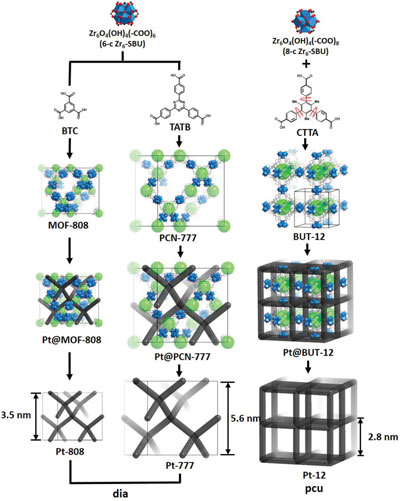| Apr 23, 2019 | |
Nanocasting platinum in MOFs(Nanowerk News) Nanocasting is a synthetic process in which precursors are solidified in the replica phases of templates to afford self standing porous structures. This strategy is powerful for creating nanoporous materials that are difficult to synthesize by the conventional bottom-up processes. |
|
| Specifically, nanocasting has been explored for the syntheses of nanoporous metals, metal oxides, carbon, and other inorganic materials. A long-standing objective in this context is to design well-defined structures that serve as templates for constructing porous 3D architectures with a high level of precision. | |
| Metal–organic frameworks (MOFs) are a class of nanoporous crystalline materials with well-defined structures and high surface areas. MOFs are ideally suited as templates for nanocasting process because of their high porosities, accessible interconnected pore structures, and crystalline backbones. | |
| However, The difficulty of using MOFs as templates for nanocasting lies in controlling the process such that casting occurs exclusively inside of the internal void space instead of aggregation on the external surface of the crystal. | |
| Reporting their findings in Advanced Materials ("Casting Nanoporous Platinum in Metal–Organic Frameworks"), researchers demonstrate that metallic platinum (Pt) structures can be effectively casted into zirconium-based MOFs by a two-step infiltration/reduction process. | |
 |
|
| Illustration of nanocasting NP-Pt networks in MOF-808, PCN-777, and BUT-12 with tunable metrics and structure types. The isolated pores in MOFs are represented by green spheres. (Reprinted with permission by Wiley-VCH Verlag) (click on image to enlarge) | |
| Upon removal of the MOF template, the team obtained nanoporous Pt networks (NP-Pt) with periodic order and high internal surface areas. They show that the key to avoiding aggregation on MOFs is to cast the Pt selectively into the continuous channels but not within spatially isolated pores. | |
| Tailoring the structure types and pore metrics of MOF templates directly translates to the formation of nanoporous platinum networks of different topologies and with the highest reported internal surface areas for platinum known to date. | |
| The casted NP-Pt networks exhibit excellent catalytic activities for methanol electrooxidation and the performance of different NP-Pt networks show a direct correlation between the materials’ surface area and catalytic performance. | |
| "Compared to traditional casting templates, the molecularly defined and rationally designed structures of MOFs as well as their high porosities and surface areas render them ideal scaffolds for the formation of nanoporous metal networks with an unprecedented level of control over the metal’s structure type and pore metrics," the authors conclude. "Inspired by the large structural diversity of MOFs with varied pore environments and topologies, we expect the approach reported in here to be applicable to a vast variety of MOF-templated nanostructures." |
 By
Michael
Berger
– Michael is author of three books by the Royal Society of Chemistry:
Nano-Society: Pushing the Boundaries of Technology,
Nanotechnology: The Future is Tiny, and
Nanoengineering: The Skills and Tools Making Technology Invisible
Copyright ©
Nanowerk LLC
By
Michael
Berger
– Michael is author of three books by the Royal Society of Chemistry:
Nano-Society: Pushing the Boundaries of Technology,
Nanotechnology: The Future is Tiny, and
Nanoengineering: The Skills and Tools Making Technology Invisible
Copyright ©
Nanowerk LLC
|
|
|
Subscribe to a free copy of one of our daily Nanowerk Newsletter Email Digests with a compilation of all of the day's news. |
